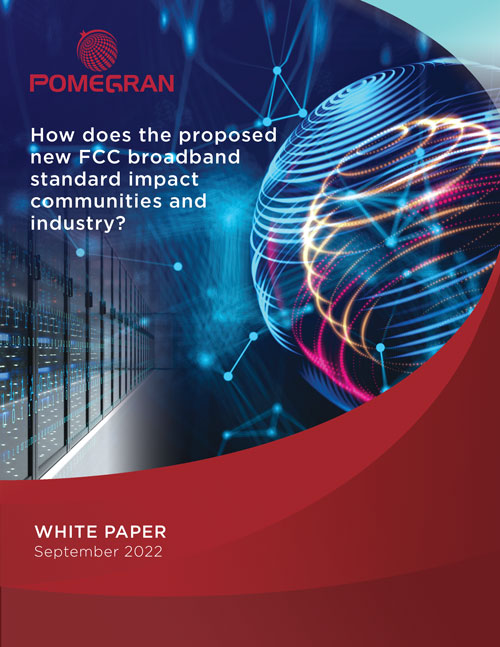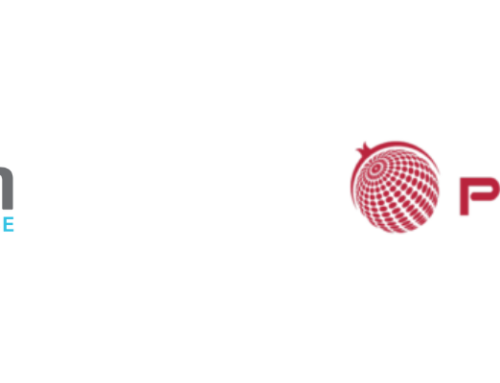
Introduction
The COVID pandemic has dramatically shown how reliant we are on the Internet for work, play and social interaction. People who lack access to high-speed Internet (hereto referred to as “broadband”), don’t just miss out, but they may fall behind. Broadband services have gone from a nice to have to an essential service. Furthermore, the pandemic has also exposed that today’s broadband speeds, which the U.S. and Canadian Governments set 5+ years ago, are insufficient for the needs of today’s society.
The COVID pandemic has dramatically shown how reliant we are on the Internet for work, play and social interaction. People who lack access to high-speed Internet (hereto referred to as “broadband”), don’t just miss out, but they may fall behind. Broadband services have gone from a nice to have to an essential service. Furthermore, the pandemic has also exposed that today’s broadband speeds, which the U.S. and Canadian Governments set 5+ years ago, are insufficient for the needs of today’s society.
This is especially pronounced in rural, first nations/tribal and other underserved communities, where lack of broadband can limit people’s ability to work or learn online, or properly receive government support or digital health services. Traditionally, Internet Service Providers (“ISPs”) that service these markets deploy, fixed wireless, digital subscriber line (“xDSL”), cable or satellite technologies. However, none of these technologies generally offer the broadband speeds, especially in rural areas, that meet the Federal Communications Commission (“FCC”) definition of broadband, namely 25 Mbps download and 3 Mbps upload (“25/3”).
Part of the problem that ISPs have in serving rural or under-served markets with broadband services, is that they typically have low housing density which translates into higher deployment costs. This is further compounded by the fact that their customers may not be able to afford the higher priced and more profitable higher internet speed packages that are common in cities.
In the U.S., the FCC sets the standard for a minimum broadband speed that serves as the benchmark for its determination whether broadband “is being deployed to all Americans in a reasonable and timely fashion”. In Canada, the Canadian Radio-television and Telecommunications Commission (“CRTC”), is the regulatory agency that establishes broadband speed standards.
On July 15, 2022, the FCC Chairwoman,1 Jessica Rosenworcel, put forth a Notice of Inquiry initiating the FCC’s annual evaluation of the state of broadband across the U.S. As part of her assessment, Chairwoman proposed increasing the national standard for minimum broadband speeds, and proposed setting a new benchmark for broadband speed to 100/20 Mbps.
In addition, it was proposed, for the first time, that the FCC should consider “affordability, adoption, availability, and equitable access” in determining whether broadband is being deployed sufficiently.
This whitepaper will exam FCC Chairwoman’s recent Notice of Inquiry, especially as it relates to rural and under-served markets, and its implications regarding:
- Current broadband standards.
- The gap in providing broadband access in Canada and the U.S.
- How this change will impact consumers and the broadband industry.
- Government programs that are available to address this gap.
- Why is there a need to increase the broadband standard to 100/20?

Setting a New Broadband Standard
According to a recent Tufts University study,2 only 29% of those living in rural U.S. have access to the FCC broadband benchmark today, compared to 67% in non-rural areas.
If the FCC expands the definition to include Chairwoman Rosenworcel’s affordability, adoption, availability, and equitable access, as part of the determinant factors, it could expand the number of under-served Americans to 140 million.
The FCC, under Section 706(b) of the Telecommunications Act of 1996 (P.L. 104-104) (Section 706 hereinafter), defines the minimum national broadband speed. If through its annual review, they determine that the standard is insufficient, they are directed to take action to accelerate deployment through the establishment of new broadband programs or to use regulatory tools to remove barriers to infrastructure, investment, and competition.3
In 1996, the FCC set the national broadband standard at 200 Kbps. In 2010, they upgraded the standard to 4/1 Mbps. In the FCC’s 2010 Broadband Progress Report,4 they justified updating the standard as necessary to accommodate video alongside basic browsing.
In July 2015, the FCC raised the U.S. national broadband standard to 25/3 Mbps, while the Canadian government has defined broadband as 50/10. In their associated broadband progress report, they specifically took issue with the lack of broadband connectivity in rural and tribal areas. According to their report, 53% of rural consumers didn’t have access to 25/3 Internet speeds, and in tribal lands that rose to 63%.
Against the 2015 FCC mandate, the industry’s largest broadband providers argued that the 4/1 threshold continued to meet consumer broadband needs, while FCC Commissioners argued that 25/3 speed wasn’t necessary as most consumers could stream High Definition (“HD”) videos at 4 Mbps.
On July 15, 2022, the FCC put forth a Notice of Inquiry initiating the FCC’s annual evaluation of the state of broadband across the U.S. As part of the assessment, Chairwoman Rosenworcel proposed increasing the national standard for minimum broadband speeds, and proposed setting a new benchmark for broadband speed to 100 Mbps/20 Mbps (termed as 100/20). The Notice of Inquiry was generally well-received and acknowledged to be long overdue, the cable and fibre broadband providers criticized the proposal as misguided as it focused on benchmark speeds that they, cable and fibre broadband providers, currently met or exceeded, while not addressing issues such as:
- Symmetric Bandwidth – being able to send as much information as you receive.
- Low Latency –reducing the lag time it takes for information to go from its source to a computer, laptop, etc.; or
- Concurrency – providing a consistent quality of experience, regardless of the number of participants or where they are physically located.
It is important to note that the above criteria play to the strengths and capabilities of cable and fibre broadband networks.
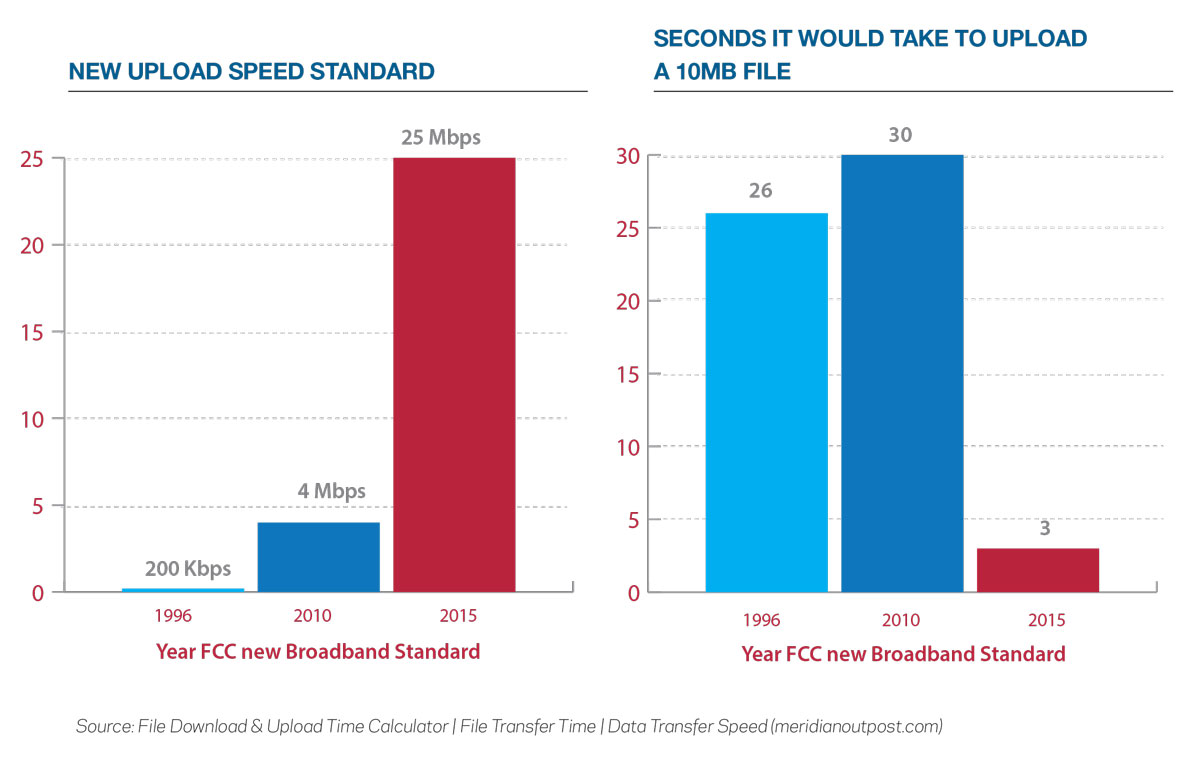
The Gap in Providing Broadband
In 2022, there is still a significant gap in availability and access to broadband connectivity in rural and first nation/tribal markets both in Canada and the United States. According to the FCC, in 2021:
- 6.6 Million of all U.S. population did not have access to at least 25/3 broadband services in 2021, compared to 26Million in 2016. However when looking solely at rural households, this fell to 41.9 Million rural population did not have access to at least 25/3 broadband services compared to 105.4 Million in 2016.
- 92% of U.S. households had access to 100/20 broadband services, up from 65% in 2016.


However, how the FCC calculates the number of U.S. households without broadband access is based on a fundamental flaw. The FCC uses, as the basis for its estimates, the semi-annual, self-reporting by ISPs using the FCC-mandated “Form 477.” It is widely acknowledged that the flaw with Form 477 is that if an ISP offers service to at least one household in a census block (see Appendix on what a census block is), then the FCC counts the household population within the census block as covered by the ISP. Adjusting for this error, analysts estimate at least 42 million Americans lack access to broadband Internet. Tufts University,7 further expanded on this research, incorporating the criteria that FCC Chairwoman Rosenworcel included in her recent Notice of Inquiry: affordability, adoption, availability, and equitable access. Based on these expanded criteria, they estimate that 172 million Americans are under-served.
In Canada, according to the CRTC:
- In 2020, 89.5% of Canadians had access to 50/10 broadband services, while only 54.3% of rural and 39% of First Nations households, respectively, had access.
- In 2021, 93.5% of Canadian households had access to 100/20 or better broadband services. However only 17% of households subscribed to 50 – 99 Mbps broadband services, and an additional 22% of Canadian households subscribe to less than 50/10 service. The most commonly cited reason for not subscribing to the higher speed services was cost.

Government Programs That Address This Gap
Over the past several years both the Canadian and United States governments have initiated several large-scale programs to narrow or eliminate this gap. The U.S. Government has over the past 5+ years committed over $200 billion on broadband initiatives. Some of the largest programs include:
Infrastructure Investment and Jobs Act: allocates $65 billion for broadband improvements.
Broadband Equity, Access and Deployment (BEAD) Program: includes $42.45 billion focused on connecting under-served areas by funneling money through state grants. Each State will receive an initial allocation of $100 million, with additional funding to be distributed, based on FCC coverage maps. In order to receive funding, states must submit a five-year action plan that identifies locations that should be prioritized for support; outlines how to serve unconnected locations; and assesses how long it would take to build out universal broadband.
Affordable Connectivity Program: $14.2 billion in funding to subsidize monthly Internet connectivity, the FCC has said more than 12 million households had enrolled in the program as of June 2022.
Tribal Broadband Connectivity Program: $2 billion in funding.
Rural Utilities Service Distance Learning: $2 billion in funding.
Telemedicine and Broadband Program: $2 billion in funding.
Since 2015, Government of Canada investments have helped more than 175,000 rural and remote households across Canada gain access to high-speed Internet. The Canadian government has committed Can$7.2 billion to broadband Internet infrastructure, including:
Universal Broadband Fund: The Universal Broadband Fund program is now closed for applications. The application guide details the UBF application requirements and provides information on assessment criteria. The $2.75 billion Universal Broadband Fund supports high-speed Internet projects in rural and remote communities. The UBF includes:
- Up to $50 million for mobile Internet projects that primarily benefit Indigenous peoples, including projects along highways and roads where mobile connectivity is lacking.
- Up to $750 million for large, high-impact projects.
- A Rapid Response Stream for ‘shovel-ready’ projects that can be completed quickly.
CRTC Broadband Fund: The CRTC Broadband Fund supports projects that provide Internet and mobile wireless services in eligible under-served areas of Canada.
Canada Infrastructure Bank: The Canada Infrastructure Bank provides loans and equity for large-scale broadband projects in unserved and under-served communities.
Low Earth Orbit (LEO) Satellite Capacity Agreement: The Low Earth Orbit (LEO) Satellite Capacity Agreement with Telesat secures capacity on LEO satellites to connect the most challenging areas in Canada to high-speed Internet. Telesat will make LEO capacity available to Internet service providers in designated remote and satellite-dependent communities at a reduced, fixed price per month.
Connect to Innovate: The Connect to Innovate program supports backbone infrastructure projects to connect institutions like schools and hospitals. A portion of funding also supports last-mile infrastructure to connect households and businesses.
First Nation Infrastructure Fund: The First Nation Infrastructure Fund provides funding to improve the quality of life and the environment of First Nation communities by addressing the long-standing infrastructure gaps on reserves in eight project categories, including connectivity.
Investing in Canada Program – Rural and Northern Communities Infrastructure Stream: The Rural and Northern Communities Infrastructure Stream of the Investing in Canada Program supports a variety of infrastructure projects, including broadband, in rural and northern communities through bilateral agreements with each province and territory.
In addition, provincial governments either independently or in partnership with the Federal Government offer their own broadband funding programs, including, but not limited to:
- The Government of Ontario has committed nearly
$4 billion to ensure all Ontarians have access to high-speed Internet by the end of 2025. - The Quebec Government, in partnership with the Federal Government, has committed $826 million to connect nearly 150,000 homes to high-speed Internet by September 2022.
While Governments should be lauded for their commitment and funding to provide broadband for all of its citizens, critics say they do not go far enough because some of their funding initiatives do not necessarily focus enough on:
- People/households being served vs coverage areas.
- Providing affordable broadband services/digital equity.
- Quality of the service to ensure the best user experience.
- Addressing under-served markets, irrespective if they are rural or urban.
- Aligning and ensuring that the funding benefits or improves local economic development, education, public safety, health care, and industry and in rural markets the agricultural sector; and
- Community outreach to ensure that it addresses the needs of potential customers.
A lot of the newer government programs require local and state/provincial governments as part of their planning, submission and funding process to address the above issues and concerns.
Why increase the broadband standard to 100/20 Mbps?
COVID has exposed that the broadband standards that Governments established more than 5 years ago are insufficient for the needs of today’s society, and that without access to affordable broadband services, a significant segment (42 – 147 million people) of the Canadian and U.S. populations are being left behind. In addition, research shows that higher broadband speeds lead to improvement in both societal and economic development, not just as the national but also the local level. According to:
Analysis Group:8
Cities with over a Gigabit connection, had an overall healthier economy. In their research, Analysis Group compared 14 metropolitan U.S. areas, where more than 50% of the population had access to broadband, to 41 neighboring cities without it, and they reported that cities with Ggigabit connections, could support a 1.1% higher gross domestic product than other “slow Internet” cities.
Deloitte:9
Deloitte redicted that a “10% point increase of broadband penetration in the U.S., in 2016 would have resulted in more than 806,000 additional jobs in 2019. According to their analyses, adding 10 Mbps to average download speeds in 2016 would have resulted in more than 139,000 additional jobs by 2019.
Moreover, they found a strong correlation between broadband availability and jobs and GDP growth. A 10% point increase of broadband access in 2014 would have resulted in more than 875,000 additional U.S. jobs and U$186 billion more in economic output in 2019. In addition, their research showed gains in jobs were stronger when Internet speeds increased from 50 to 100 Mbps than the gains in jobs from increases in Internet speeds then from 100 to 150 Mbps.
Brookings Institute:10
Increasing access and usage of broadband infrastructure in rural areas leads to higher property values, increased job and population growth, higher rates of new business formation, and lower unemployment rates. Broadband expansion can also improve health and life outcomes, by offering access to remote healthcare providers, online social networks, and educational opportunities. In their cost-benefit analysis of rural Indiana, they found a 3x – 4x returns on investment, not including state and local governments’ cost savings on medical expenditures and additional tax revenues from increased incomes as a result of broadband network expansion.
The Potential Impact of Moving to a New Broadband Standard
Consumers:
Will benefit from the ubiquity of broadband services irrespective of where they are located, which will help reduce the digital divide, and will vastly expand their ability of consumers to do HD video conferencing for accessing education, health care or government services. This will especially be true if the FCC expands their definition of what constitutes access to broadband services to include affordability and digital equity.
Equipment Manufacturers:
xDSL, fixed wireless, and satellite equipment (excluding new players like Starlink) may have to invest in R&D as their equipment may not meet the proposed new speed requirements. In addition, most of these services rely on asymmetrical download/upload services (e.g., 25/3, 50/10 or 100/20), while FCC Chairwoman Rosenworcel and several U.S. Senators are pushing for symmetrical (e.g., 100/100) services, which are increasingly popular with services like video conferencing.
The Broadband Industry:
While companies that serve urban and densely populated areas may not have problems adjusting to the increase in the new proposed speed benchmark. According to the NCTA – The Internet and Television Association the industry trade and lobbying association for medium-sized and large cable companies, the average U.S. (cable) download speed has grown to 226 Mbps in June 2022.
However, for ISPs that serve rural and under-served markets, the new proposed FCC standard(s) of:

If accepted, this could pose potential severe challenges to their business. In that, if these ISPs are unable to raise their broadband speeds or address affordability and digital inequality issues (potential key determinant in future Government funding), they could see their customers migrate to companies that offer newer technology delivery services (see Appendix – Newer technology delivery services for greater details), such as:
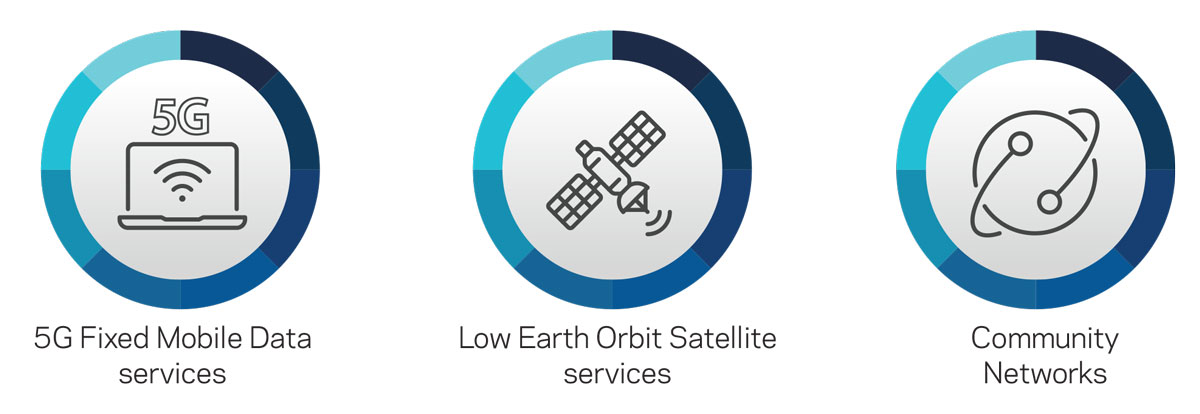
In addition, broadband providers that rely on asymmetrical services delivery technologies (e.g., xDSL, wireless or most satellite) may have to upgrade their network to either newer technologies or fibre, which in rural low population dense areas may not make economic sense without significant Government support.
Government funding of broadband initiatives.
Should the new standards go into effect, the Government may have to rethink their incentives and grant programs This will especially be true if the FCC Commissioners (2 of the 4 commissioners are Republican and the U.S. Senate has yet to confirm Gigi Sohn’s (Dem.) nomination) agree to include symmetry, affordability, and digital equity as part of the new standards. Currently several U.S. States are including up to 1 Gbps speeds, affordability, and digital equity in their criteria for their allocation of Federally funded grants and programs.
In addition, the FCC will need to consider how increasing the national broadband standard may affect ISPs ability to deploy certain technologies in areas of:
- low population density which may make it either economically or technically not feasible, or
- with high poverty rates where affordability plays a key role in broadband adoption.
In a global context, the European Union (“EU”) has proposed its Gigabit Society goal that by 2030, all European households will be covered by a Gigabit network; while China is implementing a national broadband mandate, which stipulates 1 Gbps wired and wireless speeds for all.
Conclusion
FCC Chairwoman’s July 15, 2022, Notice of Inquiry is a very strong step in the right direction in updating the U.S. benchmark for determining whether broadband “is being deployed to all Americans in a reasonable and timely fashion”. The pandemic has shown that:
- The current benchmark of 25/3 is insufficient in the age of video conferencing, online education, telemedicine services, etc.
- Having access to broadband services is not the same as having the ability to afford it.
- Rural and under-served communities’ broadband needs are still not being met, and they are falling further behind their richer urban community counterparts.
- The FCC’s calculation of what constitutes “under-served” may need to be recalibrated to better reflect affordability and other qualitative issues, rather than just relying on Form 477.
In addition, the FCC in their consideration in updating the benchmark, should include:
- The potential hardship (reasonableness) on the broadband industry of moving from an asymmetrical (e.g., 25/3 to 100/20) to a symmetrical (100/100) standard.Moving to symmetrical speeds would dramatically improve user experience, especially as it relates to video conferencing. However, rural ISPs have traditionally delivered their broadband services via asymmetric (xDSL, fixed wireless, satellite) technologies which were never intended to deliver symmetric speeds. If the Government were to mandate that rural ISPs migrate from these legacy technologies to symmetric network services, many could suffer severe financial harm, because of the associated capital costs in rebuilding their networks.
- Moving beyond the buzz of a 1 Gbps broadband society (research indicates that there is a low correlation between higher societal and economic growth as one moves beyond 100/20 speeds), to a more practical and broader goal of having a larger percentage of the population having not just access to, but the ability to afford 100/20 broadband services. This may mean expanding end-user subsidies to ensure that rural and urban broadband communities have ‘parity”, which was one of the key mandates with the Telecommunications Act of 1996.
Lastly, the U.S. Government may want to allocate some of its broadband grant initiatives to xDSL and wireless equipment manufacturers to fund research into expanding the speed and capabilities of their technology to meet the new benchmark standards. These technlogies, for at least the foreseeable future (7-10 years), will still be the most economical way to reach low population density households and communities.
Appendix 1 – What is an FCC Census Block?
According to the U.S. Census Bureau,11 a census block is:
Statistical areas bounded by visible features such as roads, streams, and railroad tracks, and by non-visible boundaries such as property lines, city, township, school district, county limits and short line-of-sight extensions of roads.
The building blocks for all geographic boundaries the Census Bureau tabulates data for, such as tracts, places, and American Indian Reservations.
Generally small in area, within a city, a census block looks like a city block bounded on all sides by streets. Census blocks in suburban and rural areas may be large, irregular, and bounded by a variety of features, such as roads, streams, and transmission lines. In remote areas, census blocks may encompass hundreds of square miles.
Numbered uniquely with a four-digit census block number ranging from 0000 to 9999 nesting within each census tract, which nest within state and county. The first digit of the census block number identifies the block group. Block numbers beginning with a zero (in Block Group 0) are associated with water-only areas.
Delineated by the U.S. Census Bureau once every ten years. An automated computer process looks for all visible and nonvisible features in our geographic database (MAF/TIGER) that should be a block boundary and creates a block each time those features create a polygon.
The smallest level of geography you can get basic demographic data for, such as total population by age, sex, and race.
Census blocks are not:
Delineated based on population. In fact, many census blocks do not have any population.
They may be split when a change in another geographic boundary occurs, such as an incorporated place annexation. If a block is split in between decades, a suffix will be added to the block number. For example, block 1000 would become block 1000A and 1000B.
A boundary that can be used with American Community Survey (ACS) data. ACS data only go down to the block group level.

Appendix 2 – How much Internet speed do you need?
To better understand why current national broadband standards may be insufficient to meet the needs of consumers, it helps know how much Internet speed does the average consumer or household need:
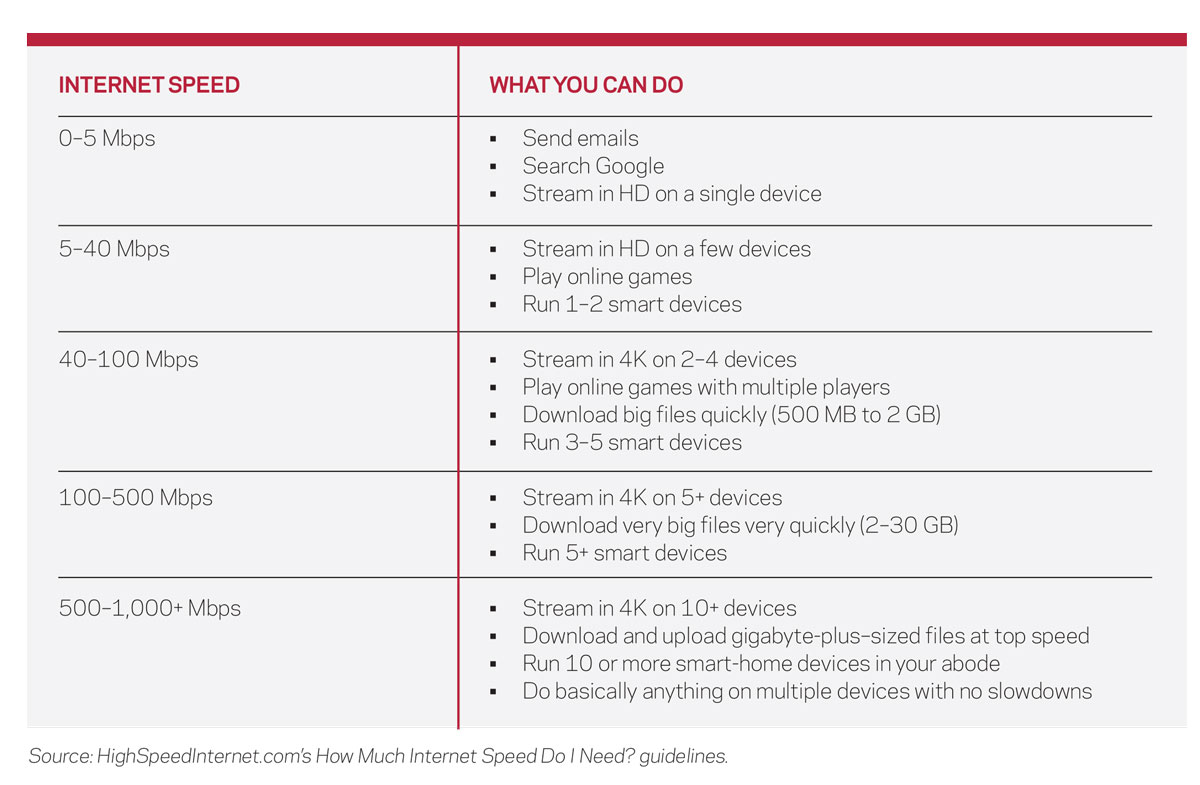
Based on the usage, most consumers need at least 25 Mbps, while the average household (2.5 people) would need at least 100 Mbps to ensure that they don’t suffer from slowdowns or buffering.
Reference
- FCC’s Rosenworcel proposes ‘100/20’ as new broadband minimum requirement,
www.firecetelecom, July 18, 2022 - Broadband Infrastructure Funding and the Digital Divide: Prioritizing People Over Miles, https://sites.tufts.edu/digitalplanet/broadband-infrastructure-funding-and-the-digital-divide-prioritizing-people-over-miles/, 2021
- Raising the Minimum Fixed Broadband Speed Benchmark: Background and Selected Issues, Congressional Research Service, July 12, 2021
- The FCC Definition of Broadband: Analysis and History, www.broadbandnow.com, November 2, 2021
- BROADBAND AVAILABILITY UPDATE: NEW FCC DATA FOR DECEMBER 2020, Technology Policy Institute, November 3, 2021
- BROADBAND AVAILABILITY UPDATE: NEW FCC DATA FOR DECEMBER 2020, Technology Policy Institute, November 3, 2021
- Broadband Infrastructure Funding and the Digital Divide: Prioritizing People Over Miles, 2022
- High-Speed Internet for Business and the Economic Impact, https://blog.tdsbusiness.com/, January 28, 2021
- NEW DELOITTE STUDY EXPLORES THE ECONOMIC IMPACTS OF BROADBAND, www.connectednation.org, June 10, 2021
- The benefits and costs of broadband expansion, August 18 2021
- https://www.census.gov/newsroom/blogs/random-samplings/2011/07/what-are-census-blocks.html
About the Author

Rob Klein is Vice President, Fibre Business Strategy at PomeGran Inc. (www.pomegran.io) whose mission is to become the dominant fibre-centric broadband service provider serving under-served residential, enterprise and government customers in rural and under-served communities across Eastern Canada and the Northeast United States. PomeGran wants to ensure that No One is Left Behind, a mantra that reflects our core values of social responsibility.
Prior to joining PomeGran, Rob held various senior executive positions in Canadian/U.S. private and public telecommunications and technology companies. Rob was part of the executive team that helped Globalive launch Wind Mobile (Freedom Mobile) in 2008, and helped co-found the Application Service Provider (precursor to SaaS and Cloud computing) industry in the late 1990’s. In addition, Rob has authored two case studies for the Blockchain Research Institute.

